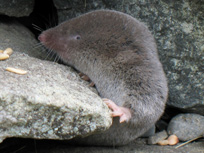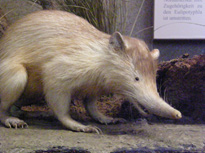Soricomorpha -- Shrewd and Holes; Shrews and Moles



Origins
The Soricomorphs ( it means shrew-shaped) are one of the most ancient order of mammals and are among the most varied and adaptable ones to boot. They evolved in the Eocene and are significantly different in body characterisitics from the rodents and other insect eaters to merit their own order. These folks are notorious for their extremely fast-paced life ( New Yorkers lead a sopoforic life by comparison) and have to feed all the time when not fighting with each other, or their food.
What are they like?
Although its external appearance is generally that of a long-nosed mouse, a shrew is not a rodent, as mice are, and not closely related to rodents. Shrew feet have five toes; rodent feet have four, and shrews have sharp, spike-like teeth, not the familiar gnawing front incisor teeth of rodents. The largest species is the House Shrew (Suncus murinus) of tropical Asia which is about 15 cm long and weighs around 100 grams; several are very small, notably the Etruscan Shrew (Suncus etruscus) which at about 3.5 cm and 2 grams is the smallest living terrestrial mammal.
Shrews are quite unusual among mammals as they are the only other ones apart from bats to use echolocation. They do so to understand the territory they are in because they have quite feeble eyesight. Some shrews also have a venomous bite that can be quite a powerful nuerotoxin for large prey.
Moles are really shrews which are slightly less frenetic and live mostly underground. Some moles have completely lost their eyesight but most can see a little. They do have amazing hearing and mostly carry spade-like front feet; perfectly adapted for digging and swimming.
Solenodons are quite amazing because they have retained a lot of the primitive characteristics of early mammalians. Solenodons look like large shrews with slightly longer snouts. In fact, some solenodons have a ball and socket joint to increase the flexibility of the snout for foraging invertebrates. Apart from being venomous, the females have teats that are near the buttocks of the animal. One wonders how and why this adaptation came about?
Geographic Distribution
View Larger Map
Shrews and moles are found in practically every crevice around the world except for very cold climates. Solenodons are actually highly endangered and are only found in the Carribean.
Reproduction
Female shrews can have up to ten litters a year, and the animals only stop breeding in the winter in temperate zones, and breed all year round in the tropics. Shrews have a gestation period of 17 to 32 days. The female often becomes pregnant within a day or so of giving birth, and feeds her current litter milk during her pregnancy, weaning one litter as the next is born. Shrews live for between 12 and 30 months. That is a very short life for a mammal!. Moles can live a bit longer and information on solenodons is rather patchy except that their litters are much smaller.
Feeding Habits
Shrews have very high metabolism and will eat anything including each other if given a chance! Moles and solenodons will hunt for insect and invertibrates and also gorge off carrion if they can find it. These creature truly define the meaning of the term "omnivorous"
Families within Soricomorpha
Soricidae (Shrews)
Talpidae (Moles)
Solenodontidae (Solenodons)
Nesophontidae (West Indian Shrews EXTINCT!)
Videos